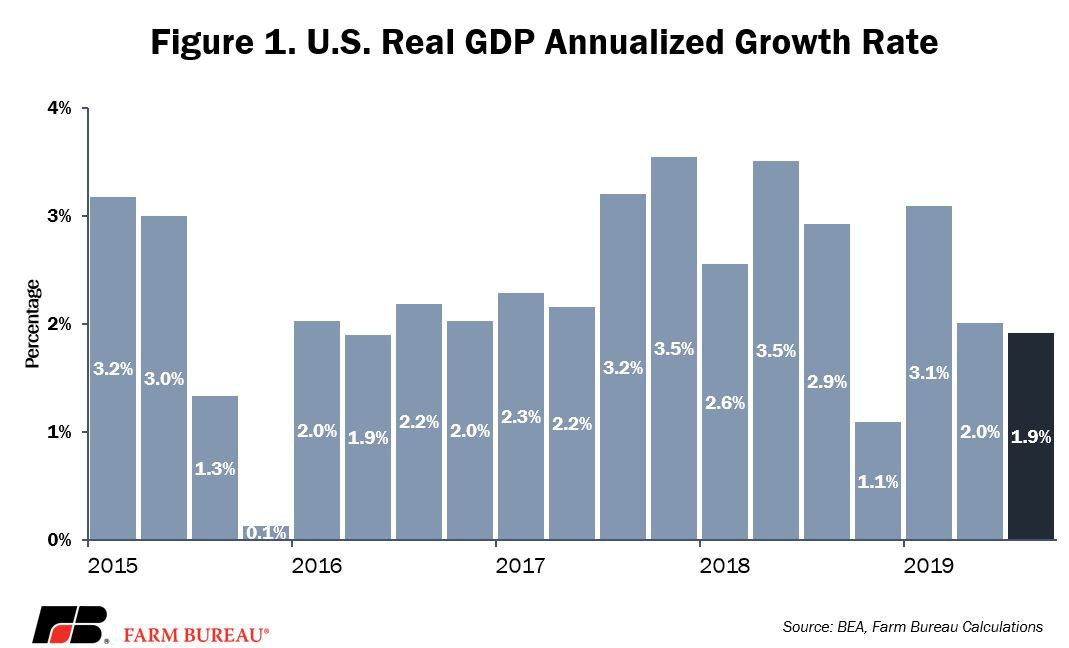Happy Consumers Drive Solid Economy, Though Potential Downturn Still Looms
Bob Young
President

photo credit: AFBF Photo, Mike Tomko
Bob Young
President
There have been a lot of economic reports and events over the last couple of weeks: the third-quarter gross domestic product report, jobs report, Federal Reserve action, potential movement on a China trade deal, new records in equity markets and on and on. One of the most telling, however, may have been an editorial in the Washington Post over the weekend that included the comments:
Still, there’s no point denying that — at the moment — things are pretty good. Americans are enjoying positive conditions in the areas that matter most: jobs, inflation, wages. The latest government statistics confirm that unemployment remains near a 50-year low, and wages are growing at an annualized 3 percent rate.
Washington Post, Editorial Board, November 2, 2019
Let’s work through some of those recent reports, indicators and actions to try to figure out how all of these forces are pushing and pulling the economy.
The third-quarter GDP report showed the economy growing at 1.9% (seasonal adjusted annual rate) over the previous quarter. Not bad, but it is a downshift from where we were last year and from where we have been since mid-2017. In effect, we are now on the back end of the impact of the tax cuts and the initial bump from regulatory reform.

Consumers are still trying to do their part. Personal consumption expenditures added 1.9% to GDP growth, indicating all the other parts of the economy contributed a net zero. Business fixed investment averaged a little over 0.5% growth from the fourth quarter of 2017 through the first quarter of 2019. In the last two quarters, however, BFI has been a drag of 0.25% and 0.22%. The Purchasing Managers Index report for October, released on Nov. 1, pegged manager’s sentiment at 48.3. That figure is slightly higher than the September figure of 47.8, but any number below 50 indicates purchasing managers think their business activity is shrinking. Exports were up in the third quarter, adding 0.09% to the economy, but at the same time, imports also rose, dragging the economy back by 0.17%.
The jobs report came in at 128,000 new positions, and on top of that, revisions to the August and September reports put another 88,000 jobs on the books. Taken all together, this jobs report says we are at least in the “OK” zone. Taking that top-end number apart, leisure and hospitality – the largest employment sector – has been very positive for three consecutive months. We have added over 140,000 jobs in leisure and hospitality since August. People are still going out to eat and to the movies. One surprise in the report is the health care sector, which added only 14,000 jobs. In the previous four months we averaged better than 30,000 slots per month here. Manufacturing employment dropped by 41,000 jobs, with 39,100 of those positions in motor vehicles and parts. Read that as the GM strike. As those workers come back to the job in November, this will have a big impact in the other direction. Also, from the jobs report, average weekly earnings rose by 3.2% on an annual basis.
The household labor survey indicated there were 241,000 more people in jobs in October, but the number of people in the labor force grew by 325,000. This drove the unemployment rate up by 10 basis points. Still, an unemployment rate of 3.6% is pretty darn good.
Job growth and rising wages, taken together, suggest the consumer confidence and spending growth witnessed in the third quarter has a solid basis.
What about the reasons people think we may be headed for a downturn?
Inverted interest rate curves have been discussed several times in this column. The shape of the interest rate curve has not changed much over the last month, and the latest action by the Federal Reserve to lower the overnight rate is not likely to drive any major shifts in the next few weeks – at least. Flight to quality, interest rate policy by other national banks and a general expectation of future Fed cuts are all contributing to holding down the far end of the curve. This will remain a concern for many economists, recognizing the past reliability of this indicator.
We have already discussed the downshift in manufacturing activity. Businesses are also holding back on spending in some areas. While, non-residential construction spending grew every quarter since the first quarter of 2016, this category contracted in the second and third quarters of 2019. At the same time, spending on residential construction has been fairly anemic since the start of 2018, showing a slight uptick in the most recent quarter.
And then there is trade. Exports did add to the general economy in the third quarter, but by less than a tenth of a percent. Imports were a drag, but the size of the drag was noticeably less than in previous quarters.
What is probably the most alarming note is not so much what is going on here at home, but rather activity in the rest of the world. The International Monetary Fund’s October World Economic Outlook report stated:
After slowing sharply in the last three quarters of 2018, the pace of global economic activity remains weak. Momentum in manufacturing activity has weakened substantially, to levels not seen since the global financial crisis.
International Monetary Fund
The IMF has lowered its projection of global economic growth to 3% for 2019, a drop of 0.3% from their April projection. They do expect growth to move back into the 3.4% range for 2020, based on a projection of improved performance of some emerging markets.
So, where does that leave us? Effectively where we have been for a while: Reliant on the willingness of our consumers to keep the economy going. Job growth and wage improvement are putting consumers in relatively good spirits. When consumers feel like they have money, things happen. The most recent jobs report suggests we are continuing this expansion at a steady pace. Take the GM strike numbers out of the picture and it was a very strong report. Those jobs will likely come back over the next couple of months, suggesting we will continue to have solid job numbers for at least the rest of the year.
So, the Washington Post is not wrong on this one. “…at the moment — things are pretty good.”
Trending Topics
VIEW ALL